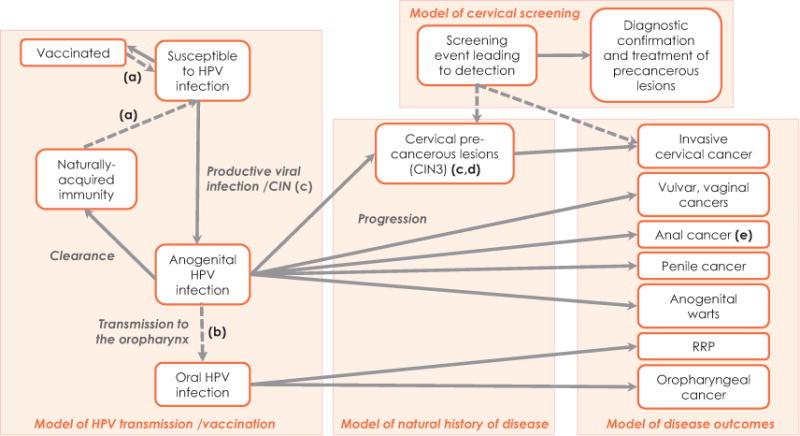Figure 13.

Model of HPV transmission and vaccination, the natural history of disease, disease outcomes and cervical screening: Schematic diagram to inform future implementations.
(a) Type-specific vaccination and naturally-acquired immunity can be modeled. Both vaccine-induced and naturally-acquired immunity can be modeled as waning over time. If the duration of immunity to HPV infection is modeled as lifelong, individuals do not become susceptible to re-infections with the same HPV type. Although vaccine can be delivered on a population basis, only susceptible individuals can be effectively vaccinated with current generation prophylactic vaccines.
(b) Anogenital to oral HPV transmission has not generally been modeled explicitly in the evaluations conducted to date.
(c) Several models to date have used the histological CIN1-3 designation to represent natural history states, but the natural history schematic depicted here is designed to inform future evaluations by reflecting the most current biological understanding of the natural history of HPV infection of the cervix. However, this does not necessarily imply that there are no transitory states between infection and CIN3 that are relevant to modeling; rather that future models should attempt to capture the best current understanding of underlying biological processes.
(d) In practice, precancerous lesions should ideally be incorporated into models of HPV transmission since they are more likely to arise from persistent HPV infections.
(e) In the future, male vaccination may be implemented in conjunction with anal cancer screening and intermediate states (i.e., anal intraepithelial neoplasia) and this will need to be reflected in comprehensive models.
CIN: Cervical intraepithelial neoplasia; RRP: Recurrent respiratory papillomatosis.
Reproduced with permission from Canfell K et al. [16].
